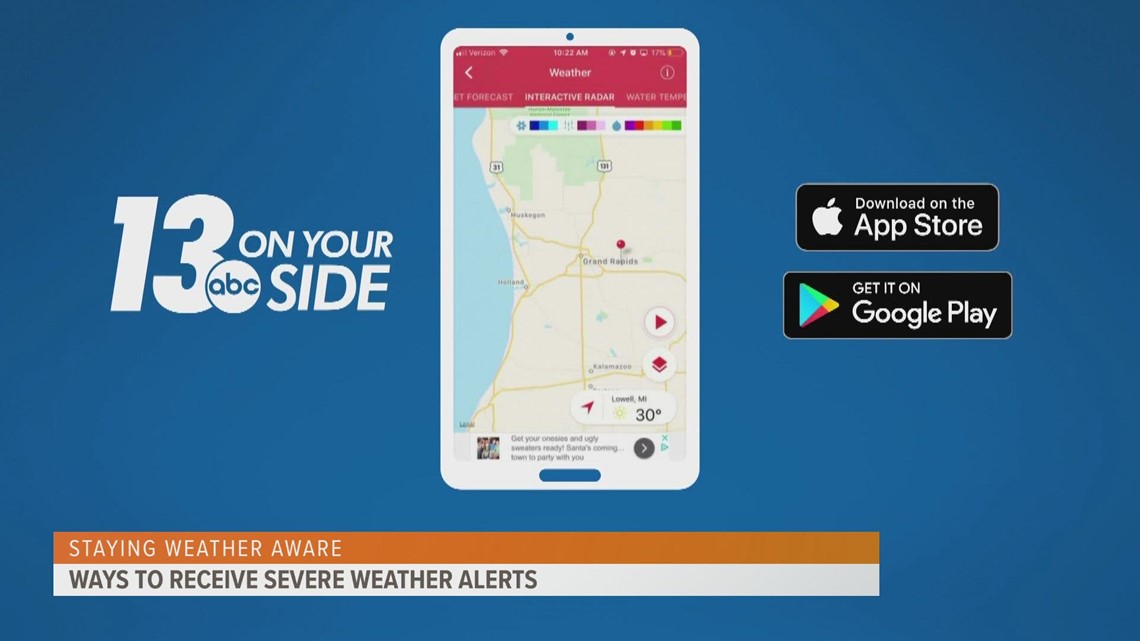Before severe weather hits, it’s important to have a plan to obtain vital weather information. Here are the best ways to receive weather alerts.
GRAND RAPIDS, Mich. — As severe weather approaches, there is usually little time left to make life-saving decisions. For your safety, it is important that you have multiple ways to stay informed about weather conditions and disseminate critical weather information.
While all of these methods are great, none are foolproof. So we suggest you have two ways to receive alerts at any time.
WAYS TO GET WEATHER ALERTS
You should have several ways to stay informed about the weather and receive critical weather information:
The first is NOAA Weather Radio. We often call them “smoke detectors” in bad weather because they automatically sound an alarm in the event of a natural disaster or bad weather.
There’s also always your local TV channel. The 13 ON YOUR SIDE Weather Service broadcasts on-air and online during an active storm.
Download the 13 ON YOUR SIDE app now. When you open the app, you can enable active alerts to be sent to your location in your area.
You can check the latest severe weather warnings here.
Local radio stations should alert you if a storm occurs in your area. You can even set up devices like Alexa and Google Home to alert you with weather notifications.
Your smartphones also offer many ways to receive critical weather alerts. We have a 13 ON YOUR SIDE weather app that will allow you to track the storm and receive alerts.
Download our weather app from the App Store for Apple devices or for your Android device here.
- Nixle is a FREE comprehensive alert system designed for rapid dissemination of public alerts and information to various public mechanisms.
- Emergency alerts and information are received via text, email, web and social media in real time for localized emergencies relevant to the community.
- To sign up for NIXLE ALERTS
- Text your postcode to 888777
- Register and create a user profile on
Outdoor sirens are also an option, as they are triggered when there is a threat of immediate danger, but are only intended to be heard outside. So if you are indoors, this should not be how you receive your severe weather alerts. Outdoor sirens can also be unreliable, difficult to hear for people who are hard of hearing, and go off for reasons other than tornadoes.
NOAA Weather Radios:
- Are designed for all-hazards warning and can be modified to alert people with special needs, including the deaf and hard of hearing, the blind, etc.
- Are programmed to notify you of hazards in your area including tornadoes, severe thunderstorms, straight-line winds, downbursts, hail, hazardous material spills, flooding, and more.
- Will give you specific information about the storm and emergency protective measures you need to take.
- Are automatically triggered by local NOAA weather radio towers when a warning is issued. Notifications occur a few seconds after the warning.
- Battery operated and works when there is no power. Some models are portable while others also have an AM/FM radio and alarm clock.
- On average costs $20.00 per unit. The devices cost no more to maintain than smoke detectors.
SHARE PHOTOS and VIDEOS
If you would like to add to our reports, send your photos along with your name and location to 616-559-1310.
►Make it easy to follow more stories like this. Download the 13 ON YOUR SIDE app now.
Do you have a current tip? E-mail [email protected]visit our the Facebook page Or Twitter. Subscribe to our Youtube channel.
Watch 13 ON YOUR SIDE for free on Roku, Amazon Fire TV Stick, Apple TV and on your phone.








